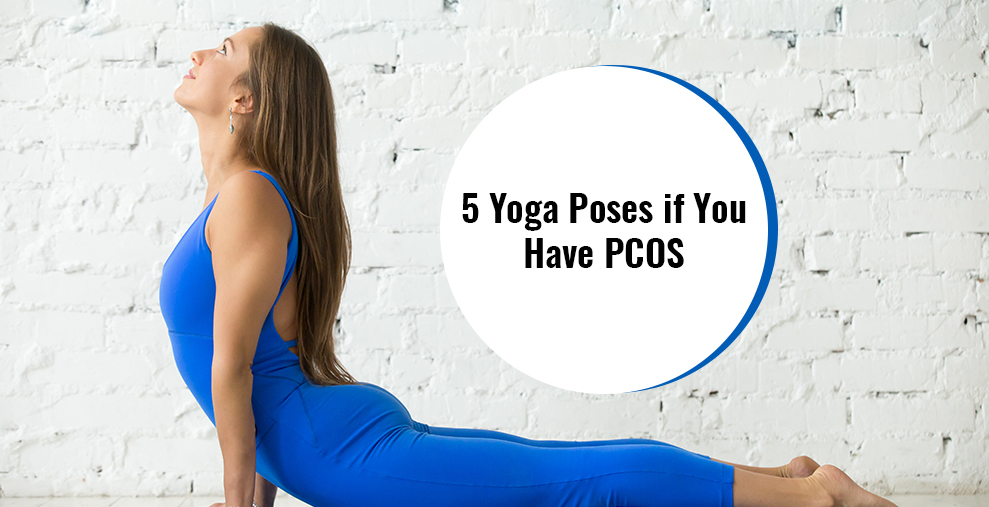What is PCOS?
Polycystic ovary syndrome (PCOS) is a condition that affects woman’s hormone levels. Women with this condition produce higher amount of male hormones. This imbalance in their hormones causes to skip menstrual periods and makes it harder to get pregnant. It causes hair growth on the face and body, and baldness. It can result in long-term health problems like diabetes and heart disease.
1. Cobra Pose
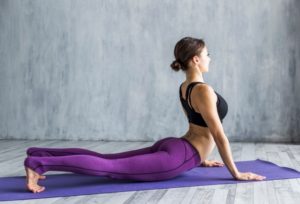
Cobra pose
1. Lie flat on the floor. Stretch your legs back, tops of the feet on the floor. Spread your hands on the floor under your shoulders. Hug the elbows back into your body.
2. Press the tops of the feet and thighs and the pubis firmly into the floor.
3. When inhaling, begin to straighten the arms to lift the chest off the floor, going only to the height at which you can maintain a connection through your pubis to your legs. Press the tailbone toward the pubis and lift the pubis toward the navel. Narrow the hip points. Firm but don’t harden the buttocks.
4. Firm the shoulder blades against the back, puffing the side ribs forward. Lift through the top of the sternum but avoid pushing the front ribs forward, which only hardens the lower back.
5. Hold the pose anywhere from 15 to 30 seconds, breathing easily. Release back to the floor with an exhalation.
2. Camel Pose
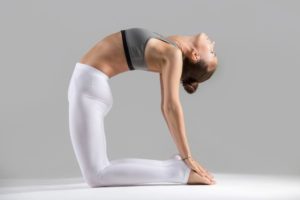
Camel pose
1. Begin by kneeling upright with your knees hip-distance apart. Rotate your thighs inward and press your shins and the tops of your feet into the floor. Do not squeeze your buttocks.
2. Rest your hands on the back of your pelvis, with your fingers pointing to the floor. Lengthen your tailbone down toward the floor and widen the back of your pelvis.
3. Lean back, with your chin slightly tucked toward your chest. Beginners can stay here, keeping their hands on their back pelvis.
4. If you are comfortable here, you can take the pose even deeper. Reach back and hold onto each heel. Your palms should rest on your heels with your fingers pointing toward your toes and your thumbs holding the outside of each foot.
5. Keep your thighs perpendicular to the floor, with your hips directly over your knees. If it is difficult to grasp your heels without feeling compression in your low back, tuck your toes to elevate your heels. You can also rest your hands on yoga blocks placed to the outside of each foot.
6. Lift up through your pelvis, keeping your lower spine long. Turn your arms outward without squeezing your shoulder blades. Keep your head in a neutral position, or allow it to drop back without straining or crunching your neck.
7. Hold for 30-60 seconds. To release, bring your hands back to your front hips. Inhale, lead with your heart, and lift your torso by pushing your hips down toward the floor. Your head should come up last. Rest in Child’s Pose (Balasana) or Corpse Pose (Savasana).
3. Boat Pose
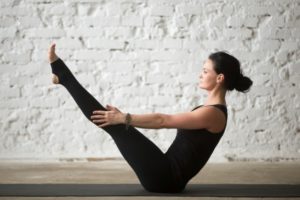
Boat pose
1. Begin in a seated position with your knees bent and your feet flat on the floor.
2. Lift your feet off the floor. Keep your knees bent at first. Bring your shins parallel to the floor. This is half boat pose.
3. Your torso will naturally fall back, but do not let the spine round.
4. Straighten your legs to a 45-degree angle if you can do so without losing the integrity of your upper body. You want to keep your torso as upright as possible so that it makes a V shape with the legs.
5. Roll your shoulders back and straighten your arms roughly parallel to the floor with your palms turned up.
6. Focus on lifting your chest to support the balance.
7. Stay for at least five breaths.
8. Release your legs on an exhale. Then inhale and sit up.
4. Half Moon Pose
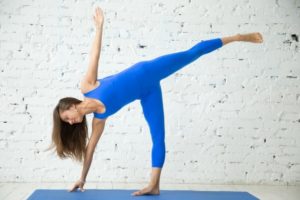
Half moon pose
1. Perform Utthita Trikonasana to the right side, with your left hand resting on the left hip. Inhale, bend your right knee, and slide your left foot about 6 to 12 inches forward along the floor. At the same time, reach your right hand forward, beyond the little-toe side of the right foot, at least 12 inches.
2. Exhale, press your right hand and right heel firmly into the floor, and straighten your right leg, simultaneously lifting the left leg parallel (or a little above parallel) to the floor. Extend actively through the left heel to keep the raised leg strong. Be careful not to lock (and so hyperextend) the standing knee: make sure the kneecap is aligned straight forward and isn’t turned inward.
3. Rotate your upper torso to the left, but keep the left hip moving slightly forward. Most beginners should keep the left hand on the left hip and the head in a neutral position, gazing forward.
4. Bear the body’s weight mostly on the standing leg. Press the lower hand lightly to the floor, using it to intelligently regulate your balance. Lift the inner ankle of the standing foot strongly upward, as if drawing energy from the floor into the standing groin.
5. Stay in this position for 30 seconds to 1 minute. Then lower the raised leg to the floor with an exhalation, and return to Trikonasana. Then perform the pose to the left for the same length of time.
5. Bridge Pose
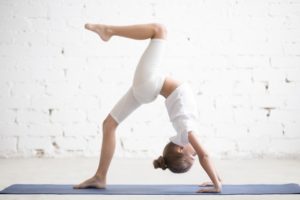
Bridge pose
1. Lie on your back with your knees bent and feet on the floor. Extend your arms along the floor, palms flat.
2. Press your feet and arms firmly into the floor. Exhale as you lift your hips toward the ceiling.
3. Draw your tailbone toward your pubic bone, holding your buttocks off the floor. Do not squeeze your glutes or flex your buttocks.
4. Roll your shoulders back and underneath your body. Clasp your hands and extend your arms along the floor beneath your pelvis. Straighten your arms as much as possible, pressing your forearms into the mat. Reach your knuckles toward your heels.
5. Keep your thighs and feet parallel — do not roll to the outer edges of your feet or let your knees drop together. Press your weight evenly across all four corners of both feet. Lengthen your tailbone toward the backs of your knees.
6. Hold for up to one minute. To release, unclasp your hands and place them palms-down alongside your body. Exhale as you slowly roll your spine along the floor. Allow your knees to drop together.
